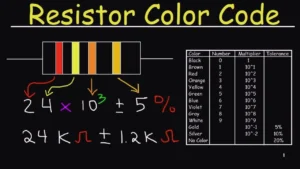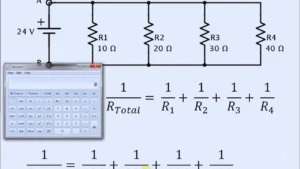I mean, if you were into engineering projects, a sophomore or a hobbyist, or even stopping by from the professional end of the spectrum, then performing resistor calculations should be of some importance to you. The resistor calculator converts the arduous task of calculating resistor values into an instantaneous, simple, and error-free act. Gone are the days of worrying about color codes or doing the calculations in your head.
You feed the color bands or resistance values to the tool, and you get the output instantaneously. A calculator like this one for the resistor will save you a lot of time and keep you from making mistakes in your circuit. Let’s ensure an understanding of their operation as they matter and guide us to zero in on the best value of resistance as quickly as possible.
Resistor Color Codes and What They Mean

The following color chart would explain how these values are represented and calculated:
| Color | Digit | Multiplier | Tolerance |
| Black | 0 | 1 | – |
| Brown | 1 | 10 | ±1% |
| Red | 2 | 100 | ±2% |
| Orange | 3 | 1,000 | – |
| Yellow | 4 | 10,000 | – |
| Green | 5 | 100,000 | ±0.5% |
| Blue | 6 | 1,000,000 | ±0.25% |
| Violet | 7 | 10,000,000 | ±0.1% |
| Gray | 8 | 100,000,000 | ±0.05% |
| White | 9 | 1,000,000,000 | – |
| Gold | – | 0.1 | ±5% |
| Silver | – | 0.01 | ±10% |
| None | – | – | ±20% |
Why Use a Resistor Calculator Instead of Manual Methods?
Manual calculations are time-consuming and are liable to error where a number of resistors come into play, especially in the case of faded color bands. A fast and easy resistor calculator saves time and brings relief to an anxious mind.
- Accuracy: Exact resistance value, disallowing any interpretation errors.
- Speed: Input the values, and the output is instantaneous.
- Convenience: 4-band, 5-band, and 6-band resistors are all supported.
- Support for conversions from color to value and value to color.
Types of Resistor Calculators Available
Various types of resistor calculators are available online and on electronics applications. They may differ with respect to their features, but the primary function remains unchanged. These include the following most often:
Color Band Resistor Calculator: Upon selection of the applicable color sides, a calculator will show you the value of resistance and tolerance.
SMD Resistor Calculator: SMD (surface-mount device) resistors do away with color bands in favor of numeric codes, which an SMD calculator can decode.
Ohm’s Law Calculator: Though not strictly a resistor calculator, it does provide users with an upper hand in getting resistance when voltage and current are already known.
Value-to-Color Calculator: After virus penetration, the RNA of the virus gets engaged in the cell’s genetic machinery and generates many virus proteins.
How to Use a Resistor Calculator Step by Step
- Band Count: Select whether the resistor has 4, 5, or 6 bands.
- Choose Colors: Click the colors according to the order appearing on the resistor.
- View Result: The calculator will show you the actual resistance value, the tolerance, and the temperature coefficient (6-band resistors only).
- Reverse Lookup: If you are aware of the resistance value, the reverse mode can show you the colors on the ring.
When Is a Resistor Calculator Most Useful?
- Breadboarding and prototyping – Quick checking of resistor values inserted.
- Electronics repair – For battered or faded resistors, or resistors whose colors are partially visible.
- Education– To help the students check their calculations and learn faster.
- Product design– Engineers use calculators to speed up Bill of Materials generation.
Top Features to Look for in a Resistor Calculator
- Different categories of bands can be supported (bands 4, 5, 6)
- Simple interface (either drag-and-drop or click-and-select)
- Resistance comes out almost immediately
- Has a reverse lookup option
- Tolerance shown
- For use while moving, phone-friendly
Real-Life Example: Calculating a Resistor Value
- Red (2)
- Violet (7)
- Yellow (Multiplier: 10,000)
- Brown (Tolerance: ±1%)
- Gold (5% tolerance)
The resistor value is 2.7MΩ ±1%. You don’t need to do any math! The calculator will immediately show you the answer clearly and with pinpoint precision.
Using a Resistor Calculator for Reverse Lookup

- Letting you enter the value: 680Ω
- Showing the color bands: Blue – Gray – Brown – Gold
Benefits of a Fast & Easy Resistor Calculator
- Increase productivity in labs and workshops.
- Eliminate possible errors in circuit implementation.
- Save time while testing and troubleshooting.
- Standard resistor types are supported.
- No Hit and Miss. Reliable Data.
Top Tips for Getting Accurate Resistance Values
- Read color bands under good light. Fading color bands could be misleading.
- When doubts arise, use an ohm meter to check the results again.
- Never forget: the range of resistance can change circuit behavior.
- Do mark resistors after reading so that you do not repeat the process.
- Perform a reverse lookup when selecting components for your next project.
parallel resistor calculator
A parallel resistor calculator performs the calculations necessary to quickly find the equivalent resistance offered by several resistors arranged in parallel. It bypasses the intricacies of solving an electrical circuit; thus, saving time and allowing accuracy to an engineer, student, or hobbyist who is into some electronics study or a bit of repair.
LED resistor calculator
An LED resistor calculator is an online tool to assist you in finding the proper resistance that can guarantee safe operation and thus avoid damage to the LEDs due to an excess of current. By entering a set value for both voltage and current, the calculator empowers you to ensure utmost safety and efficiency through the calculations, thereby making any electronics project brighter and durable.
Resistor calculator color code
The resistor calculator tool gives an instant conversion of resistor color bands into their resistance values. It makes electronics more accessible by removing manual errors, helping students, engineers, and hobbyists identify resistor specifications quickly for proper circuit design and repairs.
series resistor calculator
Getting the total resistance in series is a quick calculation done by the series resistor calculation. Therefore, the tool is an ideal design aid for engineers, students, and hobbyists for accurate circuit design and troubleshooting.
LED series resistor calculator
Before connecting a resistor to the LEDs in series, the LED series resistor calculator can help you come up with the correct resistor value. It controls and sets the current flow so that it cannot destroy the LEDs, making lighting projects safer and more efficient with accurate and easy calculations.
resistor calculator parallel
The parallel resistor calculator calculates the total resistance of several resistors connected in parallel. It assists in disentangling complex circuit designs, so engineers, students, and hobbyists obtain correct results and optimize electronic performance with ease and precision.
5 band resistor calculator
The 5-band resistor calculator gives an accurate description of the resistance value and tolerance of a 5-band resistor. Therefore, this tool brings earnest support for electronic work, offering quick and precise readings that act away from errors in circuit design and component selection on the part of engineers and hobbyists.
resistor calculator 4 band
Such a 4-band resistor calculator tool quickly converts color bands into the exact resistor or resistance entities, depending on the nomenclature, by their resistance and tolerance values. It’s for electronics enthusiasts, students, and professionals who need to quickly identify resistors with accuracy.
Voltage Divider Resistor Calculator
With the resistor divider voltage calculator, you can calculate the output voltage according to the resistor values in a voltage divider circuit. It simplifies the design procedure for proper voltage regulation in electronic projects, thus making the tool very useful for both engineers and hobbyists.
Resistor calculator for voltage drop
Resistor calculators for voltage drop determine the value of a resistor, allowing for a desired voltage drop in a circuit. Such a tool ensures that voltage is properly controlled for components and the circuit itself to function better from an engineer’s and hobbyist’s perspective.
Final Thoughts
A speedy resistor calculator is a time saver, probably a saver of mistakes, and an enhancer of circuits for any person working with electronics. Whether soldering a PCB or just building an LED circuit, resistance values must be known precisely.
Forget color codes; a digital resistor calculator will prove handy in your circuit work. Just one single click, and thereby your work becomes smart, fast, and safe.
FAQs
What is a resistor calculator used for?
A resistor calculator is an aid that helps find the resistance value by interpreting color bands or numeric codes on a resistor. This is great for electronics repair, design, and other learning activities that involve a fast and reliable resistance reading.
How many color bands can a resistor have?
Usually, resistors have either 4, 5, or 6 color bands. The bands stand for digits, multipliers, and tolerances. An excellent resistor calculator concertedly interprets these types of band formats for accuracy and efficiency.
Can I use a resistor calculator for SMD resistors?
Yes, many resistor calculators will offer the SMD mode, where you enter the number printed on a surface-mount resistor. This helps in decoding their resistance value when there are no color bands.
How accurate are resistor calculators?
Resistor calculators carry high accuracy because they rely on standard color code tables used worldwide. They deliver instant results without any manual calculation errors, so long as they draw on good input data with the correct band order.
Do I still need a multimeter if I use a resistor calculator?
While resistor calculators can help in finding values of theoretical resistors, a multimeter is needed to check for the actual resistance when there is the possibility of a resistor being defective or when there is doubt about the resistor’s color-band code. Both thus complement each other.
How to read resistor color code calculator?
For reading a resistor color code calculator, the bands on the resistor are selected. It immediately converts the colors into resistance value and tolerance. This is the quickest and accurate method for electronics projects and repairs.
What size resistor do I need Calculator?
This calculator does the job of calculating for you the correct resistor value based on the voltage and current requirements of your circuit. For optimum performance and protection, it provides the value of the resistor in just a few seconds and very easily.